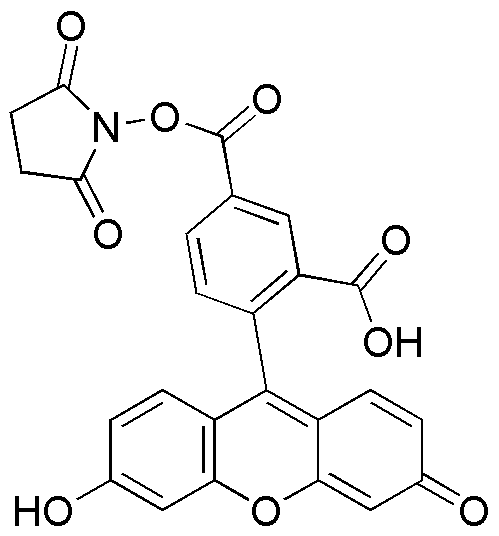5-Carboxyfluorescein N-succinimidyl ester is widely utilized in research focused on:
- Fluorescent Labeling: This compound is commonly used to label proteins and antibodies in biological research, allowing scientists to visualize and track cellular processes under a fluorescence microscope.
- Diagnostics Development: It plays a crucial role in developing diagnostic assays, particularly in immunoassays, where it helps in detecting specific biomolecules in samples, enhancing sensitivity and specificity.
- Cell Imaging: Researchers use this ester for live-cell imaging applications, enabling real-time observation of cellular dynamics and interactions, which is vital for understanding disease mechanisms.
- Drug Delivery Systems: The compound is incorporated into drug delivery vehicles to monitor the release and distribution of therapeutic agents, improving the efficacy of targeted treatments.
- Bioconjugation: It is utilized in bioconjugation processes to create stable conjugates with various biomolecules, facilitating the study of protein interactions and functions in complex biological systems.
Informations générales
Propriétés
Sécurité et réglementation
Applications
5-Carboxyfluorescein N-succinimidyl ester is widely utilized in research focused on:
- Fluorescent Labeling: This compound is commonly used to label proteins and antibodies in biological research, allowing scientists to visualize and track cellular processes under a fluorescence microscope.
- Diagnostics Development: It plays a crucial role in developing diagnostic assays, particularly in immunoassays, where it helps in detecting specific biomolecules in samples, enhancing sensitivity and specificity.
- Cell Imaging: Researchers use this ester for live-cell imaging applications, enabling real-time observation of cellular dynamics and interactions, which is vital for understanding disease mechanisms.
- Drug Delivery Systems: The compound is incorporated into drug delivery vehicles to monitor the release and distribution of therapeutic agents, improving the efficacy of targeted treatments.
- Bioconjugation: It is utilized in bioconjugation processes to create stable conjugates with various biomolecules, facilitating the study of protein interactions and functions in complex biological systems.
Documents
Fiches de données de sécurité (FDS)
La FDS fournit des informations de sécurité complètes sur la manipulation, le stockage et l’élimination du produit.
Spécifications du produit (PS)
Le PS fournit une description complète des propriétés du produit, notamment sa composition chimique, son état physique, sa pureté et les exigences de stockage. Il détaille également les plages de qualité acceptables et les applications prévues du produit.
Certificats d'analyse (COA)
Recherchez des certificats d'analyse (COA) en saisissant le numéro de lot du produit. Les numéros de lot et de lot se trouvent sur l'étiquette d'un produit, après les mots « Lot » ou « Lot de fabrication ».
Numéro de catalogue
Numéro de lot/série
Certificats d'origine (COO)
Ce certificat d'exploitation confirme le pays dans lequel le produit a été fabriqué, et détaille également les matériaux et composants utilisés et s'il est issu de sources naturelles, synthétiques ou autres sources spécifiques. Ce certificat peut être requis pour les douanes, le commerce et la conformité réglementaire.
Numéro de catalogue
Numéro de lot/série
Fiches de données de sécurité (FDS)
La FDS fournit des informations de sécurité complètes sur la manipulation, le stockage et l’élimination du produit.
DownloadSpécifications du produit (PS)
Le PS fournit une description complète des propriétés du produit, notamment sa composition chimique, son état physique, sa pureté et les exigences de stockage. Il détaille également les plages de qualité acceptables et les applications prévues du produit.
DownloadCertificats d'analyse (COA)
Recherchez des certificats d'analyse (COA) en saisissant le numéro de lot du produit. Les numéros de lot et de lot se trouvent sur l'étiquette d'un produit, après les mots « Lot » ou « Lot de fabrication ».
Numéro de catalogue
Numéro de lot/série
Certificats d'origine (COO)
Ce certificat d'exploitation confirme le pays dans lequel le produit a été fabriqué, et détaille également les matériaux et composants utilisés et s'il est issu de sources naturelles, synthétiques ou autres sources spécifiques. Ce certificat peut être requis pour les douanes, le commerce et la conformité réglementaire.


